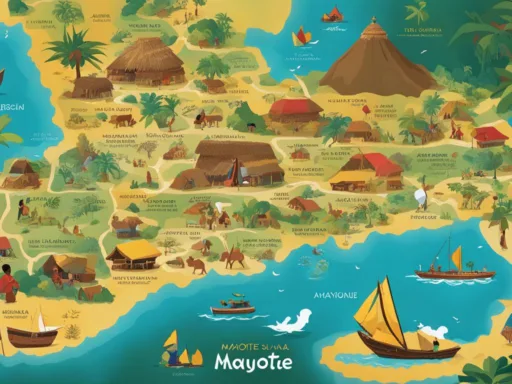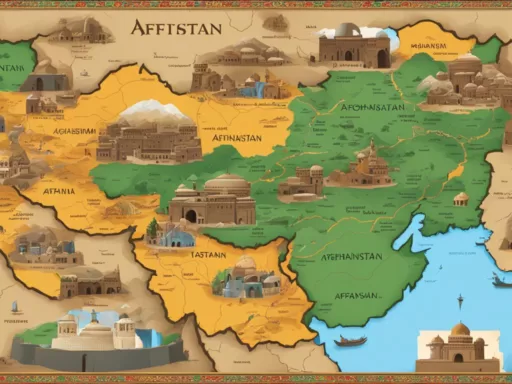Embark on a journey through a land resplendent with linguistic diversity, where the rich tapestry of languages spoken in China weaves together a narrative of cultural intricacy and historical depth. With over 1.4 billion voices contributing to its melody, China’s symphony of dialects ranges from the universally recognized Mandarin to a plethora of regional and ethnic tongues, each with its distinct cadence. This vast spectrum showcases not only the variety of Chinese languages but also the richness of the country’s heritage, where each dialect echoes tales from centuries past. Join us as we delve into an exploration of the myriad dialects of China, a testament to the enduring legacy and vibrant linguistic diversity of China.
Key Takeaways
- China not only prides itself on the ubiquity of Mandarin but also celebrates an impressive assortment of regional and ethnic Chinese languages.
- The linguistic landscape in China is far from monolithic; instead, it is characterized by an abundance of unique dialects.
- Understanding the linguistic diversity of China is key to appreciating the culture and history steeped within each language and dialect.
- The realm of languages spoken in China extends beyond speech, encapsulating a complex system of writing with deep-rooted traditions.
- Exploring China’s linguistic variance is an immersive experience that bridges the past’s wisdom with modern-day’s linguistic evolution.
The Linguistic Landscape of China
As the home to one of the world’s oldest civilizations, China hosts a rich tapestry of languages that mirror its complex history and ethnic diversity. From the bustling streets of Beijing to the remote mountains of Tibet, a wide array of languages resound, revealing the multifaceted nature of this vast nation. In an effort to appreciate the intricate linguistic landscape of China, it is imperative to understand not only the prevalence of Mandarin Chinese as the official language but also the profound diversity found within its many dialects and minority languages. Central to this linguistic story is the ideal of diversity within unity, a theme that underscores China’s distinctive linguistic panorama.

Mandarin Chinese: The Official Language
In the realm of official languages China prides, Standard Chinese, commonly known as Mandarin Chinese or Putonghua, stands at the forefront. Founded upon the dialect of Beijing, or Beijingese, Mandarin serves as the linguistic cornerstone for the country, with over 955 million people using it as their primary language. Its influence extends beyond the mainland, securing a place as one of the four official languages in Singapore and one of the six languages recognized by the United Nations.
Dialects of Chinese: Diversity Within Unity
The Chinese languages, also referred to collectively as Hanyu, span seven major language groups. Within these, countless dialects exist, each bearing their own unique linguistic features. These dialects, such as Shanghainese, Hokkien, and the widely known Cantonese, exemplify the nation’s linguistic richness. Although these languages differ as much as English does from German or Danish, the standardized writing system of Hanzi bridges these gaps, ensuring written comprehension across the various dialects, reflecting linguistic diversity China treasures.
Minority Languages: A Kaleidoscope of Linguistic Variety
Beyond the dominant Sinitic languages, China’s linguistic horizon encompasses an impressive assortment of approximately 300 minority languages. These languages, including Mongolian, Tibetan, Uighur, Zhuang, Kazakh, and Yi, are spoken by nearly 8% of the population and are indicative of the profound ethnic variety within the nation. Each minority language offers a unique lens through which to view China’s eclectic cultural mosaic and historical patrimony, cementing the rich linguistic diversity China is known for.
Linguistic Diversity China: More Than Just Local Dialects
When conversations turn to the linguistic diversity China is known for, many immediately think of Mandarin or Cantonese. However, China’s linguistic repertoire is as vast and variegated as its landscapes, stretching far beyond these familiar local dialects. This diversity encapsulates an array of languages that reflect not only the communication styles but also the rich cultural tapestries of the country’s 56 officially recognized ethnic groups.
Within the borders of this populous nation, the array of languages extends across at least nine different linguistic families, with each family presenting a world of nuance and tradition. This includes the Tai-Kadai and the Hmong-Mien, as well as the Austroasiatic language families. But beyond the spoken word, Chinese Sign Language and Tibetan Sign Language showcase the inclusive nature of communication within the nation, where efforts have been made to ensure that all communities, including those with disabilities, have their voices heard and recognized.
The importance of languages for ethnic minorities China cherishes shows the country’s commitment to maintaining the cultural identities and histories of each group. This commitment to preserving and promoting linguistic diversity within indigenous groups is a reflection of a society that values its multifaceted heritage. Each ethnic language, from the Uyghur spoken by its namesake ethnic minority in Xinjiang to the melodious lilt of Zhuang in Guangxi, contributes to the vibrancy of China’s cultural mosaic.
Here is an insight into the nuanced language families that enrich China:
- Tai-Kadai: Infused with the rhythms of Southeast Asia, these languages are primarily spoken by ethnic groups such as the Zhuang and the Dai, who reside in the verdant southern regions of China.
- Hmong-Mien: Originating from the mountainous areas, languages in this family, such as Hmong and Mien, are spoken by hill tribes with a rich tradition of folklore and textile art.
- Austroasiatic: This family includes languages like the Wa, spoken in the remote areas near China’s borders reflecting deeply rooted cross-cultural influences.
To showcase the diversity within China’s own linguistic landscape, one must not overlook the vital role of sign languages. Chinese Sign Language is used broadly among the deaf community, with its own grammar and lexicon. This embodiment of inclusivity reflects the country’s attunement to the needs of all its citizens, supporting the idea that communication, in every form, is a human right.
Summarizing the vastness of China’s language offerings in such a brief overview hardly does it justice. Instead, let us consider this a glimpse into the doorway of a world where each language and dialect is a note in the symphony of ethnic cultures and traditions—a symphony that tells a story of human expression in its most diverse forms.

Recognizing and promoting this diversity is essential not only for historical preservation but also for fostering mutual understanding and respect among China’s many vibrant communities. The rich linguistic diversity China embodies is undoubtedly a cornerstone of its past, a defining feature of its present, and a precious treasure to safeguard for the future.
Languages Spoken in China: Exploring the Most Common Languages
While Mandarin Chinese is often the first language that comes to mind when thinking about the languages spoken in China, the linguistic landscape is far more complex and vibrant. This section uncovers the primary tongues that create the symphony of sounds across this populous nation, highlighting not just the overwhelming prevalence of Mandarin but also the crucial role of local and minority languages in China.
Mandarin: The Lingua Franca of China
With over a billion speakers, Mandarin Chinese functions as the heartbeat of China’s communication. Its various dialects, including Northern Mandarin and Southwestern Mandarin, offer a mosaic of tonal variations that enrich its linguistic texture. As a tonal language, Mandarin’s tonalities encapsulate a unique aspect of its identity, with five tonal sounds—four main tones and a neutral tone—that can alter a word’s meaning entirely, making mastery a delightful challenge for linguaphiles.

Cantonese: Cultural Gateway to Southern China
In the southern corners of China, particularly in Guangzhou, Hong Kong, and Macau, Cantonese Chinese or the Yue language serves as a cultural beacon. With around 70 million speakers, its roots dig deep into Ancient Chinese, reflecting through its nine distinct tones that color its expressive nature. Cantonese not only plays a significant role in everyday interactions but also stands as a guardian of regional culture and history.
Minority Languages with Official Status
In a breathtaking display of cultural recognition, several minority languages in China are endowed with official status. The Tibetan language soars through the elevations of Tibet and Qinghai, while Mongolian echoes through the steppes of Inner Mongolia. Uighur resonates with the vibrant community in Xinjiang, and Zhuang voices the diversity of Guangxi. These languages not only offer communication but also keep alive the unique traditions and cultural essence of these ethnic groups.
| Language | Region | Number of Speakers | Official Status |
|---|---|---|---|
| Mandarin Chinese | Mainland China, Taiwan, Singapore | Over 1.1 billion | National |
| Cantonese Chinese | Guangdong, Hong Kong, Macau | Over 70 million | Regional |
| Tibetan | Tibet, Qinghai | Estimated 6 million | Regional |
| Mongolian | Inner Mongolia | Estimated 5 million | Regional |
| Uighur | Xinjiang | Estimated 10 million | Regional |
| Zhuang | Guangxi | Estimated 18 million | Regional |
Regional Varieties: The Many Colors of Chinese Languages
China’s linguistic landscape is a prismatic reflection of its complex socio-cultural fabric, with regional dialects forming the vibrant hues of this intricate mosaic. These dialects are not merely means of communication; they are profound expressions of regional importance and vital elements of the country’s linguistic heritage. They reflect the immense cultural diversity of a nation, where each region’s speech carries the echo of history and the heartbeat of community life.
Cultural Significance of Regional Dialects
In regions like Fujian, the melodious notes of Min Chinese resonate through the air, intricately linked to the identity of its speakers. It, alongside the lyrical cadence of the Wu dialect near Shanghai, serves as a vessel carrying age-old stories and traditions. These local languages, speaking volumes of China’s storied past, are as integral to the cultural landscape as the Great Wall or the Terracotta Army. They stand as living chronicles of China’s linguistic heritage, celebrated and preserved with reverence and pride.
Regional Importance of Cantonese and Others
Cantonese Chinese, with its deep tonalities and rich oral literature, is particularly significant in areas like Guangdong and among the diaspora. Its usage extends far beyond conversation, reaching into the realms of media, education, and traditional operatic arts, maintaining a robust connection with the past. The Hakka language, too, is a tapestry woven from hill and countryside, its speakers a community bound tightly by shared words and wisdom.
The regional dialects of China, such as Cantonese, Hakka, and various branches of the Min language, are pillars upholding the diverse edifice of Chinese culture. Through cadence and colloquialism, they embody a nation’s journey through time, at once unifying and distinguishing the many voices of its people.

The Impact of Language Policies on China’s Linguistic Diversity
China’s vast linguistic panorama is shaped profoundly by its language policies. While these policies prioritize the Mandarin promotion to foster national unity and effective communication, they also grapple with the complexities of language preservation, particularly for the myriad of ethnic minorities in China. Indeed, the intricacies of this linguistically rich nation underscore the importance of maintaining a balance between fostering a common language and honoring the linguistic heritage of every community.
Mandarin Promotion and Minority Language Preservation
Aiming to create a more interlinked society, China has championed Mandarin as its primary language, with the intent not only to streamline communication but to fuel socioeconomic progress. Yet, beyond the realm of Mandarin, lies a commitment to preserve the cultural essence of ethnic minorities. This endeavor to protect the native languages of disparate groups reflects an acute awareness of their intrinsic value and the role they play in shaping a culturally vibrant China.
Current strategies and reforms in language education have crystallized into initiatives designed to document and revitalize endangered dialects and tongues. These measures reflect a growing recognition of the need for linguistic diversity education, thereby enriching China’s academic and cultural tapestry.

Language Education and Literacy Efforts
Education is the cornerstone of language policies in China, where state-sponsored programs aim to cultivate Mandarin literacy while also acknowledging the languages spoken in China by various ethnic groups. Literacy efforts encompass both the expansion of Mandarin proficiency and the empowerment of minority languages through dedicated curriculum initiatives.
These dual-focused literacy efforts not only serve to elevate the standard of communication nationwide but also bolster the preservation and practice of indigenous languages. As such, language education in China is a field rich with opportunity and innovation, built upon the foundation of a nation that prides itself on its linguistic diversity and educational adaptability.
Conclusion
In traversing the pronounced linguopolitical landscape of China, one cannot help but marvel at the complex tapestry of dialects and languages that contribute to the country’s commendable linguistic plurality. From the dominant position of Mandarin facilitating cohesive nationwide dialogue to the cherished strains of countless regional and minority languages, China presents an illuminating panorama of language diversity. This rich variety serves as a bridge between the present and the past, highlighting the enduring cultural heritage that is intricately tied to each word and phrase used across the country’s expanse.
Reflecting on the policies that shape the linguistic domain of China, we see a thoughtful blend of Mandarin propagation with the conservation of the linguistic and cultural integrity of minority communities. Efforts in education and literacy exemplify the nation’s dedication to a future where every language finds its voice in the chorus of progress without forfeiting the unique melodies of its origins. It’s a commitment underpinning every facet of the nation’s soul, acknowledging that the sum of its parts—in dialects and peoples—forms the essence of its civilization.
As we conclude this exploration, the takeaway is clear: China’s language diversity is not merely a characteristic of its society but the resonant heartbeat of a cultural legacy stretching back millennia. This delicate equilibrium between advancement and preservation is woven into the nation’s fabric, symbolizing a conscientious approach to celebrating every language as a vital part of its storied tapestry. As observers and participants in this global age, we must recognize and respect the array of languages that represents the collective identity of the Chinese people—a cultural compendium awaiting our continued appreciation and understanding.
FAQ
What languages are spoken in China?
China is home to an extensive range of languages, including but not limited to Mandarin Chinese (the official language), as well as a multitude of dialects such as Cantonese, Shanghainese, Hokkien, and many others. There are also around 300 minority languages spoken by China’s ethnic groups, including Mongolian, Tibetan, Uighur, and Zhuang. All these contribute to the rich linguistic diversity China is known for.
What is the official language of China?
The official language of China is Mandarin Chinese, which is often referred to as Putonghua in the mainland and is based on the Beijing dialect. It is the language of government, media, and education across the country and is also one of the four official languages of Singapore and one of the six official languages of the United Nations.
Are the Chinese languages mutually intelligible?
Chinese languages such as Mandarin, Cantonese, Hokkien, and Shanghainese are not mutually intelligible when spoken because they differ significantly in terms of phonetics and vocabulary. However, because they share the same writing system of Hanzi (Chinese characters), there is a degree of mutual intelligibility in written form, although variations in characters can exist between regions.
Does China recognize minority languages officially?
Yes, certain minority languages have official status within their specific regions in China. For example, Tibetan is officially recognized in Tibet and parts of Qinghai; Mongolian is used in Inner Mongolia; Uighur is spoken by the Uighur people in Xinjiang, and Zhuang is widely spoken in Guangxi.
How does the Chinese Sign Language fit into the linguistic landscape of China?
Chinese Sign Language is an important part of the linguistic diversity in China, providing a means of communication for the deaf community. It is recognized and supported within the country, further highlighting the inclusive approach to language use in China’s sociolinguistic fabric.
Are there different dialects of Mandarin spoken throughout China?
Yes, Mandarin Chinese itself is categorized into different dialects, such as Northern Mandarin, which is what Standard Chinese or Putonghua is based on, and Southwestern Mandarin, among others. These dialects showcase regional variations in pronunciation, vocabulary, and even grammar.
What is the linguistic significance of Cantonese in China?
Cantonese, or Yue language, holds significant cultural and historical value in China. It is the predominant language in Guangdong province, Hong Kong, and Macau. With its system of nine tones and retention of ancient Chinese elements, Cantonese is an expressive variant of Chinese and is vital for regional identity and cultural practices.
How do language policies in China impact linguistic diversity?
Language policies in China are designed to promote the use of Mandarin as a unifying language while also working to preserve the linguistic heritage of its many ethnic minorities. Efforts include mandating Mandarin in schools and official settings, alongside protecting and promoting minority languages through education, media, and cultural initiatives.
What efforts are being made towards language education and literacy in China?
The Chinese government promotes literacy and standardized Mandarin instruction nationwide. Concurrently, measures are taken to document, support, and teach minority languages. Bilingual education programs exist in some ethnic regions, and initiatives to produce educational materials and media in minority languages are also evident.






